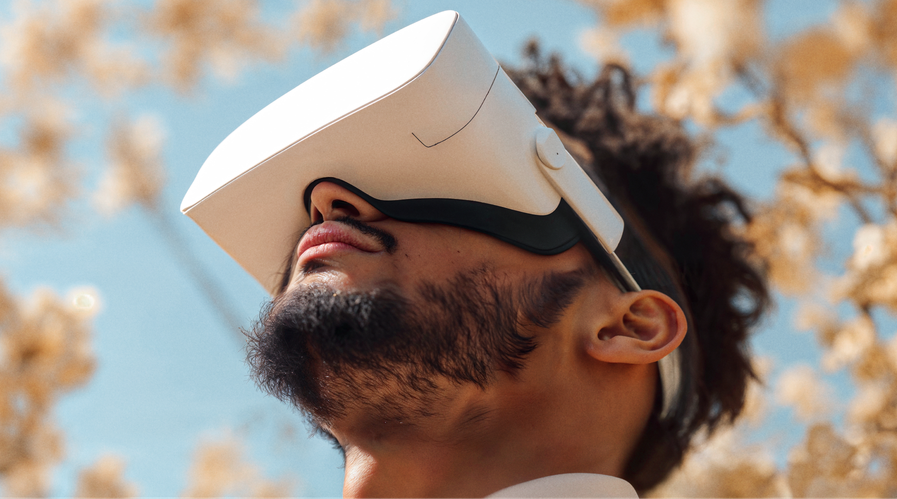
4 Ways to Start With Augmented Reality in Marketing
Published 4 Apr, 2024
Augmented reality is an underused medium in marketing. Though it's proven to drive deeper engagement and leave lasting impressions on audiences, many brands don't know where to start with AR. Dan Moller, Creative Strategist & AR Specialist at Meta, shared several tips for design and marketing leaders on getting started with the technology. He even showed us a nifty way to "sell it" to senior leadership.
The biggest developments have the biggest barriers. Most of the tools we consider table stakes today were once slapped out of the hands of some bold young designer or marketer, be it figuratively or literally.
Augmented reality (AR) sits just on the cusp of that barrier. AI wasn’t too far a leap in the information age—but for some brands, AR’s “what even is it” factor makes it feel like a big jump. It’s a shame, because brands that include AR in their marketing strategy are driving deeper engagement than their business-as-usual counterparts.
Dan Moller, Creative Strategist & AR Specialist at Meta, sat down with us to talk about how brands are getting started with augmented reality. He offered invaluable tips on how to bring AR marketing into your team’s fold, whatever barriers you face.
Why Some Brands Struggle With AR
Not everyone in the organization understands it. When most of us think of augmented reality, we’re still picturing goggles, headsets and video games… virtual reality applications. But even to those with a more comprehensive understanding of AR, Moller says plenty of design and marketing pros just don’t know where to start.
If you’re not in a space known for AR, it can seem like a huge leap with a steep barrier for entry.

Senior leadership can be a tougher sell, as they often have no point of reference for what AR is, or how it solves some of marketing’s biggest problems.
How to Start with AR In Marketing
In conversation with Phillip Maggs, our Head of New Horizons and resident creative-tech brain, Moller walked us through how you can sidestep AR’s barriers and start using AR in marketing for serious impact.
1. Have the right people
Forget about tooling for now. Before you look into your first AR experience, look at your team. You don’t necessarily need an AR “specialist” when you’re starting (though it could only help), but according to Moller, your prime candidates for in-house AR creative will be your most open-minded and divergent thinkers.
“I approach it in the way I used to approach hiring junior artists,” says Moller. “You’d get cocky artists with really specialized skills, then you’d get someone less specialized, less cocky and more excited—I’d go with the latter every time.”
You don’t want people who are too rigid right now. No one who’s advocating for the way things have always been done.

If brands want to stand out, Moller says they’ve got to be willing to work with outside-the-box thinkers with enough technical knowledge to get a workable V1 out the door. Either hire if you’ve got the budget for it, or partner up with creative marketing pros who can make it happen.
Action item:
Find or partner with capable, open-minded creatives to get started with AR. Specialization isn’t a necessity at this stage.
2. Start on small projects
Don’t feel like you have to make a statement on the first shot. In fact, doing the opposite may do more to get your digital foot in the door: Moller suggests you look for small AR testing grounds in the form of lower priority projects.
Just find a way to get an easy win for your team. A small step that you can build up from.

Where there’s lower potential for big-time screw ups, Moller says a blossoming AR team can start bouncing around ideas. Finding a way to embed a bare-bones AR experience in something as low-risk as a customer newsletter can be a start. Maybe there’s an opportunity to pump up the onboarding process for new hires, or hiring process for potential talent. It doesn’t have to be perfect, it doesn’t have to explode heads. Just find your team’s sandbox.
Action item:
List several opportunities for your marketing and/or design team to try out AR. Don’t be hamstrung by notions of perfection. Focus on testing new ideas.
3. Make social your AR avenue
Your brand’s social channels are the prime location for your AR disruption. Social platforms tend to be friendly to AR marketing as a tool, as it’s one of many things that keeps users onsite/in-app longer. Moller suggests using social media’s AR-readiness to your brand’s advantage.
Social is a good place to start trying out AR. It’s the biggest avenue for it that almost all brands share.

It’s where your audience is scrolling anyway, inundated with static images and videos. They’re used to marketing content in their feeds, but most aren’t used to marketing that interacts with their immediate surroundings. A hint of curiosity on your prospect’s part can inspire a click, at which point an AR experience can’t help but cement an impression—statistically, a deeper impression than the last 40 marketing attempts they scrolled past.
Action item:
Think of how you can use AR advertising on your socials. Note how you’ve seen other brands do it if you’re struggling, and put your own spin on it.
4. Find your advocates
Senior leadership is often where good ideas get stuck. But whatever reasons they have for their wariness, there’s almost always an “in” somewhere. Moller says this is where you’ll have to do some digging. Find the people—maybe just the one person—who’s open to AR, and make them your point person for leadership buy-in.
See where your stakeholders are holding on the least tightly, and collaborate with one of them. Then use any success as a proof point for the rest.

There’s at least one open heart on your team. Find who’s willing to hear you out, and show them where you see an opportunity for AR to strengthen their marketing plan. Crucially, keep them up to date on any wins or interesting findings in your tests, even if they don’t seem “huge”. They can bring those points of interest to other stakeholders, and use them to advocate for you.
Action item:
Talk to your stakeholders. Use past experience and knowledge of their current projects to determine who you have the best shot at talking emerging tech with, and make them your high-level contact.
Go Deeper With Augmented Reality
However humble its beginnings on your team, augmented reality as a tool is a step towards serious engagement, and way deeper resonance with your brand’s audience.
If you want to do it all in-house, build your use cases over time. It’s a lot less intimidating that way, and creates a stronger foundation for your team to use AR as a solution.
“We always want to start smaller,” Moller says of in-house teams starting with the tech. He says the best way to onboard it is bit by bit. “It’s becoming a lighter lift. Even if something [your team makes] looks like clip art, it can be enough to go off of to start the process of AR production.”
For those who’d rather start making their mark with AR immediately, our own creative AR professionals are always around for a chat.
David is a Senior Content Marketer at Superside. A former journalist with bylines too numerous to enumerate, he brings his love of storytelling and semantics to the marketing world. Recognizing the sizable gaps in the creative-as-a-service (CaaS) sector, he jumped at the chance to fill the creative void for ambitious brands. In his off hours, he enjoys loud music, making vegan meals and being made fun of for making vegan meals. He’ll gladly talk to you about any of the above on LinkedIn.














